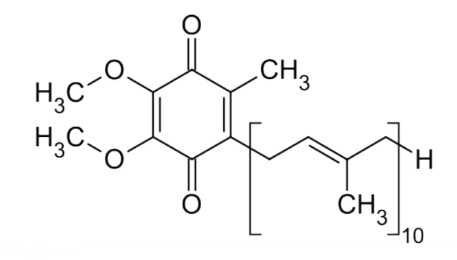Enhanced TDS
Identification & Functionality
- INCI Name
- Ingredient Name
- Manufactured By
- Vitamin Type
- Cosmetic Ingredients Functions
- Food Ingredients Functions
- Pharma & Nutraceuticals Functions
- Molecular formula
- C₅₉H₉₀O₄
- Technologies
- Product Families
- Chemical Structure

Features & Benefits
- Benefit Claims
- Labeling Claims
Applications & Uses
- Markets
- Applications
- Application Format
- Food & Nutrition Applications
- Skin Care Applications
- Use Level
- Skin Creams 0.01 - 0.1%, Body Treatment 0.01 - 0.05%
- Efficacy
Not all functions of Coenzyme Q10 in the biological systems are known yet, but many of them. Coen- zyme Q10 functions as an electron transfer agent in the respiratory chain. It’s presence in Leucocytes, Keratinocytes, Fibroblasts protect these and all other cells (as Coenzyme Q10 is ubiquitous) against very active oxygen structures like Superoxide, Singulett- Oxygene and Hydroxyl radicals, which are known to contribute to the process of aging and photoaging of the skin.
As energy transfer agent and outstanding radical scavenger Coenzyme Q10 is known for its efficacy in heart therapy, neurodermatitis, psoriasis, paradon- thosis, external substitution under stress, adipositas, immune assistance and recently against Parkinson’s disease and breast cancer. In dermal application it functions as antioxidant acting in multiple ways to reduce the effects of environmen- tal aggression to the skin, visible in the reduction of wrinkle depth and a decreased turnover time of epi- thelium.
- Incorporation
In paraffin oil it is easily soluble up to 1 % under stir- ring at about 50°C. In Phenylethanol-1 it is soluble up to 2 % under stir- ring at about 50°C.
- Application Information
- Because of its unique functions Coenzyme Q10 is an attractive ingredient for many cosmetic applications.
- In the dermis it is reduced from Ubiquinone to Ubi- quinol, the active antioxidant.
- Coenzyme Q10 prevents very effective oxidative stress in human skin cells. Furthermore, it protects from chronological and pho- toaging of dermal fibroplasts.
- It reduces the negative effects of photoaging which is shown by reducing the depth of wrinkles.
Properties
- Physical Form
- Appearance
- Yellow to orange crystalline powder
- SDS Physical and Chemical Properties
Value Units Test Method / Conditions Appearance Yellow or orange crystalline powder - - Melting Point about. 48 °C - Molecular Weight 863.37 g/mol - Particle Size 80 mesh - Density about. 0.5 g/ml - Insoluble in Water - - - Characteristics
Value Units Test Method / Conditions Heavy Metal Content max. 10 ppm Residue on Ignition max. 0.1 % - Water Content max. 0.2 % - Content Coenzyme Q10 97.0 - 103.0 % - - Application Properties
Value Units Test Method / Conditions Body Treatment 0.01 - 0.05 % - Skin Creams 0.01 - 0.1 % - Anti Age Creams 0.01 - 0.2 % -
Regulatory & Compliance
Safety & Health
- Toxicology
- Non - irritating to skin and eyes
- Non - toxic and non - cytotoxic
- Non - phototoxic
- Non mutagenic
- Coenzyme Q10 is used as dietary supplement as well. The product is classified as “safe” in the view of its toxicological evaluation.
Packaging & Availability
Storage & Handling
- Shelf Life
- 36 months
- Storage Information
Coenzyme Q10 should be stored in a dark place at temperatures below 30°C. Longer exposure to UV- rays should be avoided. In sealed containers Coenzyme Q10 has a stability of 36 months.
